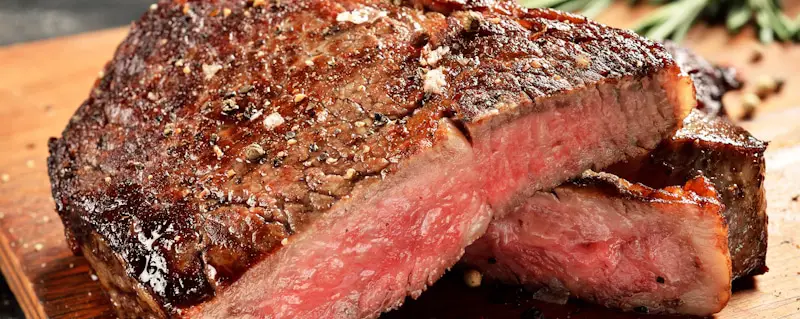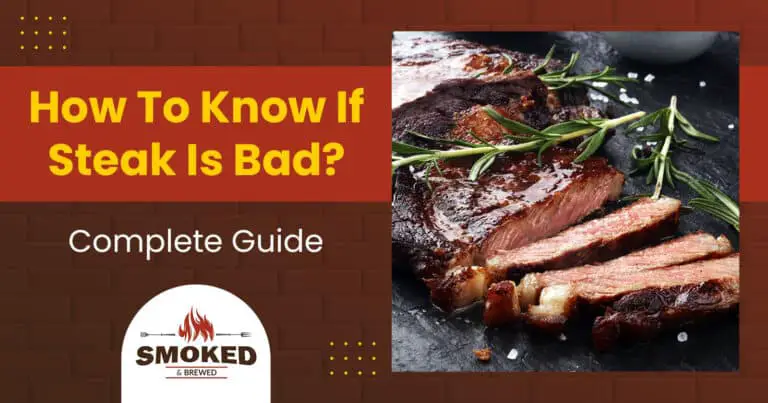Steaks are probably the most delicious tasting meat, however, they are highly vulnerable to spoilage. The dates aren’t really reliable and it is very important to learn some of the tell-tale signs of meat spoilage. Steaks can go bad when they are not properly stored, or when they are stored for too long than the recommended time. Consuming spoiled steaks can make you sick and cause health hazards.
Some of the obvious signs of spoilage of steak are – slimy texture (with or without a yellowish hue), offensive odor, has passed its due date, and uncontrolled growth of molds. Cooked steaks have a sour taste and produce an offensive odor. When stored properly, raw or cooked steak can stay for 3 to 5 days in the fridge and 6 to 12 months in the freezer.
For anyone who loves steaks, the last thing they will ever want is to fall sick. When you eat bad steak, there are high chances of food poisoning, including symptoms such as upset stomach, stomach cramps, nausea, diarrhea, vomiting, and high temperature. Continue reading to find out how and when steak can go bad and what you can do to avoid falling sick.

What Are The Essentials For Determining Spoilage Of Steak?
Have you ever been confused about the ‘sell-by’ or ‘use-by’ dates on packaged steaks? While the sell-by-date is strictly for the butchers or retailers, the use-by-date is important for end consumers. Note that if the steak has passed the date mentioned on the packaging, it may still be consumed. But before you process it, make sure to thoroughly check some of the other signs of spoilage.
To know if the steak has gone bad, the following parameters should be considered:
- The best before/ sell-by/ use-by date
- Appearance and texture
- Smell
- How long it was kept outside or in the fridge/ refrigerator
How To Know If Steak Is Bad Color?
Discoloration in color is one of the ways that can help you understand if the steak has gone bad. Different colors on steaks indicate the following:
- Purplish Red – Indicates that the meat is rich in myoglobin and the rich color is a sign of its freshness.
- Cherry Red – As the meat starts to react with oxygen in the air, it will start turning into a cherry red color. This is usually after about ½ an hour of exposure. The steak is very much consumable at this stage.
- Brown – This may just be a sign of natural discoloration. A brown hue on the steak is usually due to air exposure. At this stage, the myoglobins have been completely oxidized and there is nothing questionable about the safety of the meat.
The above-mentioned changes in colors are natural and completely normal. Certain factors can accelerate or decelerate the darkening of steaks, such as – the age of the animal, the breed, the storage conditions (exposure to light or freezing), etc.
- Green – Meat that has turned green or greenish-brown usually has a compromised quality. However, this might not be a sign of rotting. Sometimes, various pigments on the meat can produce a greenish cast when exposed to heating or processing.
- Yellow – If the steak has developed slime on its surface and it also has a yellowish hue, then it is a sure sign of spoilage. The hue is especially prominent when it is seen under natural light. The yellow-colored discoloration on the steak is caused by bacteria (usually of the species Flavobacterium and Micrococcus).
- Black/ White Molds – If you have got black-colored/ powdery molds on the steak, you may want to discard them, unless you are aging it professionally. Note that white-colored molds are okay and they are often the indicators of the natural aging of beef.
For being on the safer side, you should consider discarding the beef when you notice any signs of unnatural discoloration. Do not attempt to chop off the spoiled areas and use the rest of the meat. Sometimes these changes are not readily visible to the naked eyes and the true condition of the meat can only be established microscopically.
How To Know If The Steak Is Bad In Appearance and Texture?
The following changes can determine the freshness of the meat:
- Dryness – If the steak looks dry, shriveled, or dehydrated, it may indicate that it is from old stock. To keep the juices and the marbling intact, always ensure that the steak is first vacuum-sealed before it is stored in the refrigerator.
- Bad Smell – Raw & fresh beef has a slightly bloody and metallic smell. This fresh smell isn’t overpowering and it is usually recognizable when you sniff it closely. However, when steak has gone bad, it smells of rotten eggs and ammonia. The offensive smell can even spread through a closed room. Do remember that dry-aged steaks have a natural cheese-like smell and it is not a sign of spoilage.
- Slimy Texture – If the steak feels slimy or slippery to touch, or has a visible sheen on it, the steak has gone rancid. The bacteria built-up on the steak causes this rancidity. The spoiled steak should be immediately discarded. Most slimy steaks would develop mold on the surface within a few days of exposure.
Since slime or growth of molds may not appear all over the steak, at once, you should carefully inspect for patches and discard the entire meat even when it has minimal signs of spoilage.
How Long Can Steak Stay In The Fridge?
According to the USDA, raw steak that is tightly packed in butcher paper or plastic wrap can stay in the fridge (at 4 °C or 40 ℉) for about 3 to 5 days. Though storing steaks in the refrigerator or freezer slows down the growth of microorganisms and other metabolic activities, it is still prone to spoilage. Never keep raw or cooked steak outside or at room temperature for more than 2 hours. Steaks that are vacuum-packed are safe to eat for up to 10 days.

How To Know If Frozen Steak Is Bad?
If stored under proper conditions, steaks can be frozen for 6 to 12 months. It is best to freeze steaks in vacuum-sealed bags. Frozen steak may go bad usually because of poor packaging, delayed storage, or a drop in temperature. The following are some signs that would tell if the frozen steak has a deteriorated texture or has gone bad:
- Freezer Burnt – If the steak has developed some extremely dry patches or has a grayish or brown hue, it may be safe to eat, but will produce fewer juices and flavor.
- Ripped Packaging – If the packaging of the steak has been ripped, there are good chances of the growth of bacteria and mold due to thawing. Thoroughly inspect the steak and do not consume it if it has been stored for a long time.
- Changed Color/ Texture/ Appearance – If the steak produces an offensive smell or has a slimy texture, it is no longer safe to consume.
How To Know If Cooked Steak Is Bad?
The toxins produced from bacteria in spoiled meat may not get killed even when you cook it thoroughly. Therefore, cooked steak can also be responsible for food poisoning. Cooked and spoiled steak has a very sour taste (unlike the taste you get from marination) and a pungent smell. To avoid spoilage, the cooked steak should not be kept at a temperature lower than 140℉ (or 60℃) for more than 2 hours.
Conclusion
Always remember to consider a combination of factors before you conclude that the steak has gone bad. For example, changes in color alone should not determine the final verdict. For the safest results, always try to use fresh steaks that are cut from high-quality, grass-fed cattle.
Scot has loved smoking food in his free time for the last few years. Each major holiday or off-weekend, Scot spends days testing and prepping new recipes for perfection.

